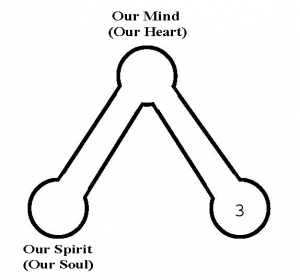THE ONLINE SEMINAR
How to Have the Living Water of Peace, Hope,
and Purpose that Jesus Promised Us
Session Four: Our Nature
Part 1
Every New Year’s Eve, thousands of people make what they call “New Year’s Resolutions” – and then break them a few days later. People promise themselves that they’ll lose weight; or exercise more; or spend more time with the children; or watch less TV; or spend less time at work. But 80 percent of them break their resolutions within 90 days.
To say it simply: People often don’t have the good behavior that they want to have. Or, to look at it in reverse, people often have the bad behavior that they don’t want to have. But why is that? Why is it so hard for people to have good behavior? More, does the fact that it’s difficult for us to have good behavior tell us something about human nature?
To begin with, it’s comforting to know that the early Christians had the same weaknesses that we have – except that they knew why it’s hard for us to have good behavior. For example, we know that Paul, the early Christian teacher, prophet, and apostle, was one of the most Spiritual people who ever lived. Yet here’s what Paul confessed in a letter to friends in 58 AD:
“I know that nothing good lives in me. At least, nothing good lives in my flesh.
I want to do praiseworthy things. But I don’t. Instead, I do the evil things that
I really don’t want to do. Yet I know this: When I do the evil things that I really
don’t want to do, it’s not me doing them – it’s sin living in me that’s doing them.”[1. Adapted from Romans, chapter 7, verses 18-20.]
Now, wait a minute. What’s going on here? This is an early Christian teacher, prophet, and apostle speaking – one of the most Spiritual people in history – yet he’s confessing that he has a problem with bad behavior and that he has a tendency to “sin” (to the early Christians, “sin” meant behaving in ways that offend God and other people). But how could that be? How could such a Spiritual person still have bad
behavior?
The answer lies in Circle Three of The Three Circles diagram. Paul is writing about an important part of our human makeup that the early Christians called our “flesh.” Worse, Paul is saying that our “flesh” is the motivational force within us that produces bad behavior. That means we really need to slow down and completely understand our “flesh.”
To help understand our “flesh,” we’re going to turn to our last circle on The Three Circles diagram that we’ve been studying since Session Two. But this is the strangest and most controversial circle on the diagram. It’s also the circle that many people dispute and deny. The reason people dispute and deny this circle is because it tells the truth about human nature. It admits that human nature is the inner force that produces bad behavior in us. However, if we’re honest about this circle and read about it with an open mind, this circle opens the door to Spiritual growth and to the most peace, hope, and purpose that humans can have on earth.
On the other hand, if we dispute and deny this circle, it’s extremely difficult (if not impossible) to grow Spiritually. The point is that the Spiritual growth process has three connected and interlocking parts (not just one or two) – and we need to discuss all three of those parts boldly and honestly. But before we actually look at the third circle on the diagram, let’s review the first two circles on the diagram.
Here’s how The Three Circles diagram looked at the end of the previous session. A brief review of each circle follows the diagram:
1. The First Circle. At the lower left of the diagram, the First Circle represents our inner spirit (or “soul”). Our inner spirit is the invisible part of us that came from God, that gives life to our bodies, and that returns to God when we die. Our inner spirit is Spiritually “dead” (asleep, passive, dormant) in its original condition at human birth, and can’t motivate us for good behavior. That’s the first reason why it’s so hard for us to have good behavior.
2. The Second Circle. At the top of the diagram, the Second Circle represents our human mind (or “heart”). Our mind is the “personal computer” in our head that allows us to understand things, make decisions, and exert will power. However, our mind is Spiritually “neutral” (indifferent, non-judgmental, uncommitted) in its natural state, and it also can’t motivate us for good behavior. Like any “programmable device,” it only waits to do what it’s told to do by a good or bad “outside program.” That’s the second reason why it’s so hard for us to have good behavior.
Now we’re ready to see The Third Circle on the diagram. As we said, it’s the strangest circle and the one that many people dispute and deny. But we can’t grow Spiritually without understanding it, so we need to look at it with total openness and awareness. We’re going to view circle three in Part 2, and we’re going open Part 2 with the true story of a young girl who died believing the wrong thing about human nature. Let’s go to Part 2 now.
All Domestic and International Rights Reserved.

